After Balenciaga’s recent Fortnite collaboration, IRL and the metaverse have never felt so blurred.
By Jonathan Wingfield
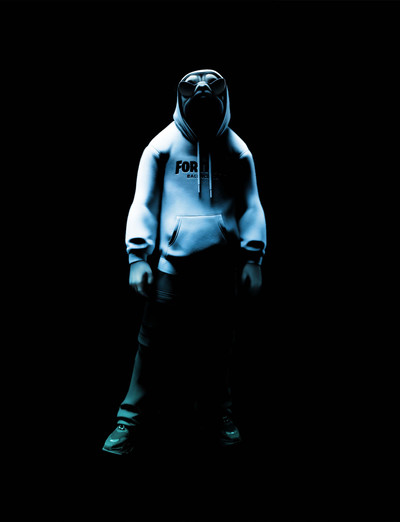
After Balenciaga’s recent Fortnite collaboration, IRL and the metaverse have never felt so blurred.
On September 20, Balenciaga revealed its collaboration with Epic Games, the $28-billion-valued company behind Fortnite. In the immensely popular multiplayer game, players control larger-than-life avatars in a vast, candy-coloured, exaggerated fantasy world where they fight to the death with shotguns, pistols and assault rifles. Thanks to the tie-up, for that following week, the avatars could go about their business in perfectly rendered, 3D versions of Balenciaga outfits. And beyond the clothes, the avatars could also model on featured billboards in the game, walk into a virtual Balenciaga store, even knock down walls with a stick-mounted version of the brand’s iconic Speed sneaker.
Balenciaga’s whole-hearted embrace of the gaming universe is the latest example of the increasingly ambitious rapport between the brand, Epic Games and its 3D software Unreal Engine, and the metaverse in general. Gvasalia has toyed with the possibilities of the virtual since 2018, when he enlisted Canadian digital artist Jon Rafman to create an apocalyptic video installation along the length of the catwalk for his Spring/Summer 2019 show. Then came Afterworld, the Autumn 2021 show created during Covid lockdown, which presented the entire collection in an immersive, video-game-like world brought to life by Unreal Engine. But where that spoke to the fashion world in new and disruptive ways, the Fortnite collaboration brought Balenciaga to a mass-market of young gamers, mostly hitherto unaware
of the brand and without the means to buy luxury fashion.
‘Meta-’ means ‘across’ or ‘after’, and the sheer scale of this latest chapter in the metaverse strained the boundaries between real life and the digital world. The huge 3D-digital billboards installed to publicize the project over Piccadilly Circus, Times Square, Shibuya Crossing, and in Seoul, felt strangely coded and subversive. Set amid frantic, hyper-coloured advertising, the monochrome ad featured a bare grey chamber occupied by a dozing, anthropomorphized bulldog –
Fortnite’s Doggo – wearing a Balenciaga white hoodie, black baggy jeans, and an insouciant air that spoke as much to Fortnite fans as the fashion brand’s devotees. The collaboration had substance, as well as style: Balenciaga opened a virtual pop-up store of digital fashion in Fortnite at the same time that the collection became available in physical stores. Despite the prize advertising locations, the real-world campaign was dwarfed by its online twin: when the Doggo billboard stood in Fortnite, it played to an audience of 400 million registered players – nearly 10 times the population of London, New York, Tokyo and Seoul combined.
Fashion obviously has history with digital, sometimes tending to treat collaborations as side-projects or gimmicks. But the Balenciaga project is no dead end. It owes its creation to advances in graphics and world building – such as those in Unreal Engine – that can finally deliver on the promise to convey the quality of luxury clothes in a virtual setting. And it demonstrated a new dimension in fashion marketing – a way for brands to find cultural traction on a massive scale. So where next? Fashion shoots in VR, physical items mirrored in online versions: all the signs point deeper into the metaverse. System spoke to Balenciaga, Epic Games and
Unreal Engine about crossing barriers, creation, identity, and what we now consume when we consume fashion.
What is it about the world of gaming that appeals to the Balenciaga brand?
Demna Gvasalia, creative director, Balenciaga: Gaming offers us a new dimension; that’s what appeals to me. I’ve long wondered about virtual fashion, but I thought, ‘Who needs it?’ Personally, I want to work with the human body, and gaming hasn’t been my comfort zone. When Cédric [Char-
bit, Balenciaga CEO] came up with the idea of doing Fortnite, I was really excited, though, because it’s something I didn’t know about. It’s like different types of embroidery in couture: ‘We can do that with the fabric.’ It’s the same thing with the virtual: ‘We can do those skins; we can create this whole Balenciaga world within the game.’ That triggered my excitement because it was so unknown to me. At the same time, I realized the importance of Balenciaga being this kind of ‘media conglomerate’, as I’ve seen people recently refer to us. It’s going in that direction; that’s why we did one of our shows in Afterworld instead of a physical show. That experience was unique – one of the most complex, but really unique. I was like, how far can we go with this?
Cédric Charbit, CEO, Balenciaga: I actually always thought it was Demna’s idea to do Fortnite! I see it as modern entertainment. Pop culture like this is massive, but because fashion does not
generally operate in this territory, it’s seen as off-limits. What we look for is innovation and modernity, and what I found interesting with Epic Games and Fortnite is exploring this idea that when we get dressed in the morning, we become characters. We remain ourselves, but we can transform into characters through our appearance, our clothes. And it’s the same with gaming and the possibilities of skins: we can really become a different person or an extension of ourselves. The opportunities within that are endless.
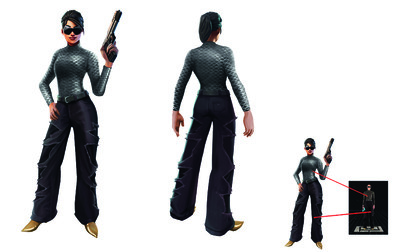
Development of the Unchained Ramirez Outfit inspired by a look from the Balenciaga Autumn/Winter 2021 collection.
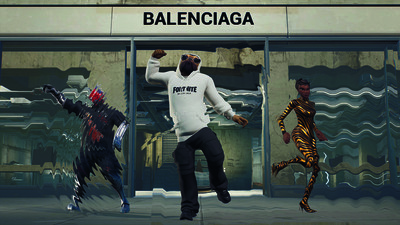
Doggo, with Knight and Banshee, in front of the Balenciaga virtual store in Fortnite.
Ever since its launch in 2017, Fortnite has invariably been described as a ‘cultural phenomenon’. In an increasingly crowded games market, what makes Fortnite different?
Emily Levy, senior manager of partnerships, Epic Games: From the beginning, Fortnite has always been a place where players can connect socially. Those social experiences have evolved, and it’s become much more than simply a battle royale game. At this point, we have 400 million registered accounts: lots of different kinds of players with lots of different interests, who want to express themselves in lots of different ways. We have outfits you can buy in the Item Shop or get as rewards by completing a challenge on the map. We have different kinds of cosmetics in the form of emotes, which are the dances you buy in the Item Shop, and including the ones seen on TikTok that we’ve brought into the game. From the very beginning, players have been swapping outfits between matches, so we know they care about what they’re wearing and how they show up to a match with friends. We’ve also seen the proliferation of new experiences in which self-expression is really at the core. For example, we have built movie screenings and film festivals inside the game. We’ve even seen runway-style experiences take off inside Fortnite’s Creative Mode, which is where users can build and publish their own interactive designs. One of our top creators, Lachlan, created a runway show where players could show up with their friends and perform emotes in their favourite outfits for the chance to win a cash prize. That video has over 11 million views on YouTube. Prior to the Fortnite partnership, Balenciaga had just cemented itself within the cultural zeitgeist between Justin Bieber and Kanye’s Donda launch and Kim Kardashian at the Met Gala. You don’t have to be able to afford Balenciaga to understand its cultural relevance; you see it everywhere on Instagram or your TikTok feed. Afterworld was an eye-opening moment for us, but even before that, Balenciaga had created these hyper-immersive runway experiences with Unreal Engine elements.
For the uninitiated, what is Unreal Engine?
Sallyann Houghton, Unreal Engine business development for fashion, Epic Games: The best way for people to think about Unreal Engine is as a creator of virtual worlds. It’s 3D software that can create photoreal environments or whatever aesthetic you choose. They can exist IRL on a virtual production stage or on a huge interactive LED screen. They can be a fully immersive interactive space – a game or on a web browser – and they can be a VR world. There are all these different routes through many platforms that let you access these realistic, fantastical, limitless worlds, where people can come together. Historically, interactive 3D spaces have been used for games, but they’re now being used to produce creative linear content. Artists and filmmakers are creating these spaces and then capturing a film, with cameras and lights, all virtual, but fundamentally exactly like they would in the real world. The same world can then be the backdrop for a fashion show, a 3D space in which virtual models and physical models move in unison and interact. In short, Unreal Engine’s superhero power is building dense, creative, high-quality interactive worlds, and Balenciaga have been trailblazers in that space. They saw the potential when UE was still publicly seen as just a gaming engine, for creating games. They saw an opportunity to leverage its qualities and show the rest of the industry what was possible.
How does a collaboration like this manage the crossover between physical and virtual worlds? And how does Unreal Engine come into that?
Emily Levy: This was our first foray into luxury fashion, so it was important to us to do something that felt super holistic. We had the outfits in the Item Shop that were also purchasable in a virtual
Balenciaga store inside the game; there were quests inside a custom Balenciaga-inspired Creative Hub – which millions of players enter daily – to earn free cosmetics; there was a photography campaign inside the game where you could strike a pose and be featured in an evolving fashion lookbook on virtual billboards; and then there were the IRL billboards in Times Square, London, Seoul and Tokyo really bringing this into our world. We pushed the boundaries of what it means to blur
physical and digital in a way that we’d never done. For the outfits we created, we picked four hyper-important, fan-favourite Fortnite characters, then looked into the Balenciaga archive and asked ourselves what these characters would choose to wear: iconic looks meeting iconic characters. We worked on things like how they posed and how the outfits were draped on the characters. Our artists and Balenciaga’s creative team paid attention to the tiniest details, from the sequins on one of the outfits, to how a character faces the camera. They used new techniques in Unreal to represent looks inspired by Demna’s creations at a granular level. We even made two of the Balenciaga outfits reactive, which means that they change over time as players complete activities on the map, something that simply can’t be replicated in real life.
Sallyann Houghton: The reason that this can exist now, and potentially wouldn’t have existed five years ago, is the 3D software. While game engines like Unreal Engine have progressed very fast over the past 10 years, it’s really only in the past 5 years that they’ve been able to take the leap from game
engines into photoreal capabilities. Once Unreal Engine became photoreal – when we were able to create dense, immersive, hyperreal environments – we were able to pull down the curtain that was believability. Before that, the interactivity of games and the landscape of gaming was always of interest and leveraged from time to time, but now, incredibly, you can create exact digital doubles, and take those digital doubles one step further to make a fantastical hyper-real version of whatever you’re trying to convey, whether it’s an emotion, clothes, people, objects or landscapes. This makes it all about the details, which is everything fashion loves – the weave, the cut, a fold, or a mood or vibe. Now you can surround a collection with an emotion. Unreal Engine can do that, so you can create
virtual spaces and worlds that are exactly as you want them to be. Creatives can come to the space and say, ‘This is how this collection looks; here are all the tear sheets’, and they can replicate that vision within a virtual world. Suddenly, all bets are off and everything’s possible.
Martina Tiefenthaler, chief creative officer, Balenciaga: There were a lot of things that Epic Games were doing, that, not being serious gamers, we didn’t even know existed. It was a long process, with lots of meetings, and then Fortnite transformed our discussions into something that Demna or I could never have even understood because it is not part of our know-how. In a way, everything I look at sits in a library in my mind, and having seen this digitalized version of our clothing I now dream differently in the real world. I say ‘dream’ because this is about the imagination – now that I know a rendered shoe can look a certain way, I might try to make a real-life shoe that looks rendered.
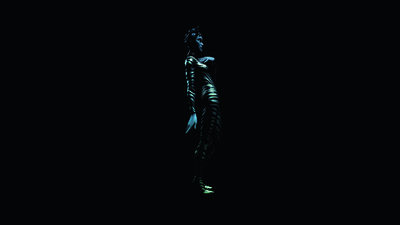
The Fashion Banshee Outfit based on Balenciaga tiger-striped leggings.
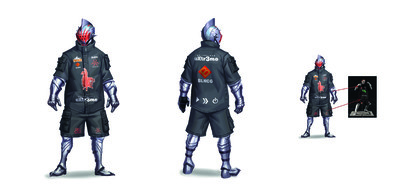
Development of the Game Knight Outfit inspired by a look from the Balenciaga Autumn 2021 collection.
The idea of fashion and gaming collaborations is not new, but it’s hard not to feel that there is something groundbreaking in the scope of what Fortnite and Balenciaga created. What makes this project less of a gimmick and more the future of brand marketing?
Emily Levy: In addition to the outfits we put into the Item Shop, the idea was to create a virtual world in Fortnite’s Creative Mode that really spoke to the authenticity of the Balenciaga brand, so we have this strange, futuristic city with the Balenciaga store in it and we put this 3D digital billboard into Fortnite above the store. It was the same billboard created in Unreal that was used in real-world advertising in the four different cities. It was also really a celebration of self-expression: players did not have to purchase the Balenciaga outfits in order to participate, which was very important. Players could wear a default skin they had received four years ago when they first downloaded the game.
What really mattered was that creators became part of a living, breathing fashion campaign, a community-driven lookbook of images of them wearing an outfit, being true to who they are, self-expressing around the Fortnite eco-system, and then to post those photos on social media. Those images were then regularly placed on the billboards in the map, so players could see their avatars wearing an outfit up on a billboard in their favourite part of Fortnite. It was an ever-evolving, user-generated content campaign where players were not only the artists and the photographers behind the campaign, but also the models. It all brings to life what the future looks like for gaming platforms, technology platforms within fashion, and a future where brands and creators are building digital assets transferable across various digital uses and media, from internal digital design and development, to gaming, to advertising, to the creation of virtual and physical items.
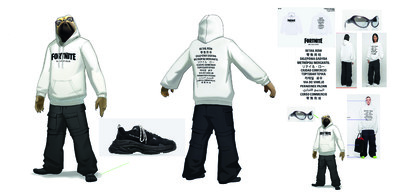
Development of the Shady Doggo Outfit based on the physical
Fortnite × Balenciaga capsule collection, 2021.
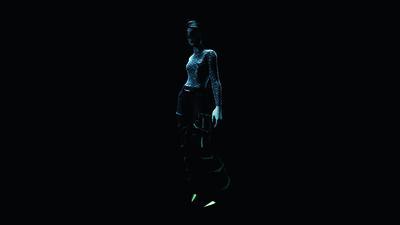
Ramirez wearing the Unchained Outfit inspired by a look from the Balenciaga Autumn/Winter 2021 collection.
How do you measure success in this new world?
Emily Levy: One way is whether it felt like an authentic experience for players – and we were completely blown away by community engagement around all parts of the activation. To us, that is a
sign that it was successful. Players loved the outfits and the detailing and thought this was a super cool new way to express themselves. Based on where I saw the 3D billboards in Seoul, London, New York, and Tokyo popping up on the Internet, they took off in their own right and had their own viral moment and got the Internet buzzing, which was really cool to see. Also, the community-driven lookbook inside of Fortnite was a really incredible experience for players. The kinds of reactions we see on Twitter when players see their art as part of the in-game experience for the first time were really mind-blowing. All these pieces made us feel like we had succeeded in creating something that
felt innovative, boundary-pushing, but also authentic for players.
How could technology such as Unreal Engine be a creative game changer for the fashion industry as a whole?
Sallyann Houghton: Compared to other industries, such as the automotive industry for example, fashion is relatively late to this technological revolution. Perhaps because, historically, fashion has had a hands-on approach, which is kind of its beauty. Fashion has appreciated innovation for a long time, but it has always been used as a way to be unique in the moment. So holograms have been used on fashion shows and robots have been used by Alexander McQueen, but it was leveraged as a marketing tool, then thrown aside. Unreal Engine now presents a huge opportunity for the fashion industry. It’s a game changer for the way shows are produced, how content is shared with the community, and how the meaning of a brand or collection can be communicated. These experiences are multifaceted – they don’t live exclusively in a virtual space, nor exclusively in camera as VFX, or the real world. That is what we mean by the metaverse: it’s a place where all these different approaches overlap. Shows are great – and people love shows – but we’ve learned that shows can go so much further and wider if they are paired with some kind of digital element. Layering these different techniques is the future of fashion and will change how the industry will be perceived by a wider audience.
Will we see more and more people using Unreal Engine within fashion?
Sallyann Houghton: Anyone can download Unreal Engine for free. Basically, anyone can pick up these tools and run with them. Our approach to the creative industry is to give people the tools to do exciting stuff, and then we invest a lot of energy producing educational resources, so that the talent can meet the incredible volume of demand for real-time skills. We are very much at a time where there’s an explosion in the need for virtual spaces, the technology has come of age, and now we need to push through the talent. In six months it will be much easier to find an Unreal artist, because there are so many people moving through that learning process. Our education team comes together with colleges and schools around the world, helping them implement Unreal Engine into their course structure. I am very proud to have a close relationship with London’s Royal College of Art, which has a vibrant fashion department and is using MetaHuman Creator, an Unreal Engine tool that allows anyone to create believable digital humans in minutes. Lots of the final student pieces last year used Unreal Engine.
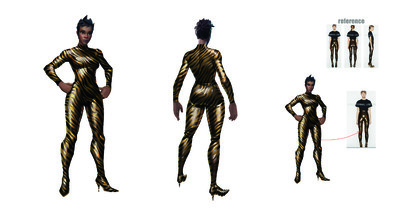
Development of the Fashion Banshee Outfit.
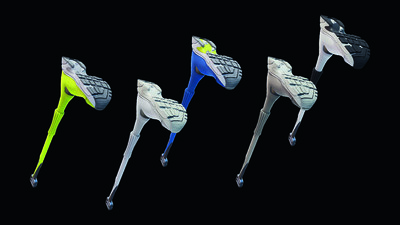
Speed Sneaker Pickaxe.
It’s feels like we’ve all been tiptoeing into the metaverse for some time, and maybe with this project we’re finally discovering that it’s arrived: 400 million avatars in Fortnite dressed up, walking past a virtual Balenciaga store. Is this the new normal? Where are we in the metaverse right now?
Sallyann Houghton: What is about to change is the way that fashion designs meet the outside world For instance, you design the most beautiful dress, and it has a real-life version. Moving forward, it may also have a digital version that is simpler to begin with, but then grows and morphs and responds to your interactions. Now a garment begins to tell a story; it has a narrative all its own. Our collaboration with Balenciaga has been incredibly important because it has pushed the boundaries of marketing campaigns, of how you can collaborate across platforms. It gave us a glimpse into what the campaigns of the future could look like.
Cédric Charbit: In the same quarter of this year that Demna presented the first couture collection – without music, in a formal and intimate manner, for an extremely limited audience, in the Avenue Georges V salon – we had the Fortnite project. It’s been a unique experience to have created this platform for Balenciaga that allows us to communicate through craft and savoir-faire and heritage in one part of the business, and in another through Fortnite. Demna’s language is completely in step with the era in which we live. That’s what I find so compelling about this moment in time for Balenciaga.
Sallyann Houghton: People are not necessarily seeing this as a strictly games-based partnership; they are seeing it as an authentic metaverse partnership and experiencing how multifaceted these interactive worlds and digital assets already are. They are beginning to develop a metaverse strategy, asking questions about how they enter this space and what they do next. I fundamentally believe that for us to move towards the metaverse, the journey will be built upon a gazillion collaborations. I think there’ll be an avalanche in the next 12 to 18 months of incredible fashion-focused metaverse executions. For example, [Epic Games division] Quixel Megascans has a huge library of sophisticated backdrops that the fashion industry will be blown away by once it realizes that they exist. If you want
to have your fashion show in a canyon, there’s a 5K, photoreal Grand Canyon at your fingertips. There are all these weird and wonderful places that brands can pull from a database really easily. Then they can build on top of the chosen image so it’s unique and owned by that brand, that label and that collection. And then when you’ve finished with it, you pop it in the archive, and every single show, every single execution, every single virtual world you have created can just be put on your metaverse map. Suddenly, the brand is developing this whole specific landscape in which it can live in perpetuity, and which contains every vision it’s had. In 2022, we will see the digital meet the physical space more fully. Collaborating with game platforms is wonderful, but brands now need to think about their long-term digital existence. In the end, the metaverse will bring the fashion industry together, and brands will all live side by side.
Demna Gvasalia: These days, we can no longer be sat here thinking, ‘Pop culture is something separate.’ It’s totally part of today’s luxury fashion industry; it’s like bringing a sneaker into a luxury brand’s product range. There are all these other facets of pop culture and for me, Fortnite and the metaverse are just two segments of that. It’s all just part of the language that a modern brand has to speak today.
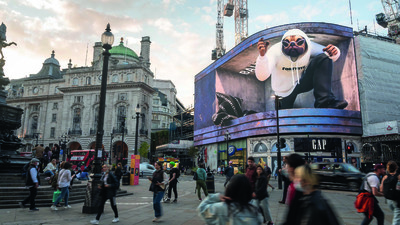
Doggo billboard in Piccadilly Square, London.
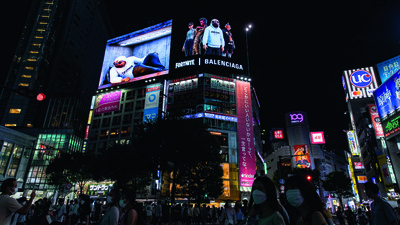
Doggo billboard in Shibuya Crossing, Tokyo.